Product Requirements:
DC power from any automobile
I can’t tell you how many times this scenario has occurred: I am driving
along, minding my own business, when I look down to see that my speedometer is
reading somewhere between five to ten miles above the legal speed limit. It can
happen both in town and on the highway – but seldom if ever in a school or
construction zone. The chances of catching me speeding can depend on what the
other traffic is like, what kind of hurry I am in, and the type of weather and
road conditions that exist. Nine times out of ten, the extra miles per hour
don’t seem like that big of a deal. I am certainly not the only driver on
the road that is speeding, and I am not doing anything crazy like vying for a
part in the next Fast and the
Furious movie.
I have gone for periods of time where I received no speeding tickets
whatsoever – my record is over 10 years. There have been times when I
received a ticket because I was doing well over the speed limit and I got caught
fair and square. But I have also been the victim of tickets from speed traps,
unfair singling out, and poorly or improperly marked speed zones.
I live in a state (Texas) that actually had to pass legislature limiting the
fraction of revenue that a town could earn from traffic tickets! You had
better believe that there are still towns here – and I would guess in your
state, too – that will post a speed limit that is a good 5mph slower than usual,
and situate a sheriff’s deputy where it is convenient to nab any offenders. If
the offenders are from out of town, then it is even better – they most likely
won’t be back to contest the ticket.
These tickets can really came back to bite you in more ways than one. Let me
explain: When you get a speeding ticket, there is not only a steep fine to pay,
but there is also an electronic note made on your driving record. After a couple
of moving violations within a set years’ period, your automobile insurance
premium will go up.
I suspect that insurance companies truly love it when their policy holders
get speeding tickets – it means that they are justified to charge more premiums.
Of course, if you get a certain number of speeding tickets in a given period –
even if they are never for more than just five miles over the limit each
time – then your insurance company will most likely drop you. They will be
completely justified in doing this, because after all – you are a habitual
offender with a lead foot, right? Until someone that works for an insurance
company tells me differently, I will continue to believe that they do not see a
difference between a ticket for five miles over the speed limit and a ticket for
thirty.
It is the same deal with the state that you live in. Get enough tickets on
your record, and at the very least your license might be suspended. The state
does not care if these tickets were for speeding a few mph above the limit or
many.
So where does that leave the person that isn’t trying to be a speed demon,
yet might need an instant reminder to slow down every now and then? That is a
person that needs a radar detector.
Now before you fall into the trap of thinking that radar detectors are only
for the Mario Andretti set, think about the last ticket you received. How fast
were you going? I bet it was no more than 10 miles per hour over the speed
limit. Were you really even paying attention to your speed? I would guess
probably not. You were most likely driving along at what seemed like the proper
speed for the road, paying attention to things like who was near you, where they
were turning, and who was about to jump in your lane. I bet you were surprised
when you saw the policeman’s lights in your mirror. I’ll bet you were even more
surprised when told you were clocked by his radar gun and the results were…you
can fill in the blank.
If you had had a radar detector in your vehicle, it would have gone off
within a certain distance of the policeman’s radar gun – warning you that if
you were speeding then you needed to slow down immediately. Obviously
this can be a very effective tool in avoiding speeding tickets, which is why I
have owned one radar detector or another since 1986.
Before I go much further, I should talk about what exactly a radar detector
does and how it works…
In order to understand how a radar detector works, you should first
understand what they are detecting. According to the
K40 site,
"Radar is an acronym for RAdio Detection And Ranging
and defines an electronic instrument that utilizes electromagnetic radio waves
to detect and locate moving or fixed objects. Based upon the Doppler Principle,
police radar guns transmit a continuous signal of electromagnetic waves at a
constant frequency to make precise speed measurements. When this signal (or
beam) strikes a moving vehicle, the signal reflected back will be of a slightly
different frequency which sensitive receivers built inside radar guns pick up
and compute into miles-per-hour (MPH).
Radar works on a basic line of sight principle. This means, in order for a
police officer to get an accurate reading, the radar gun must be able to "see"
the vehicle. Once in view, police target reflective surfaces on the car to
bounce a signal off of. Traditionally, license plates, headlights, light colored
paint, and chrome bumpers and grills are most reflective. Larger vehicles, such
as 18 wheelers, vans, buses, pick-up trucks, and SUV’s provide even better
targets compared to small cars or motorcycles.
Radar cannot detect vehicles around corners, through hills, or behind solid
objects. When two or more vehicles are on the road at the same time, a radar gun
will pick up the most reflective object it sees. Many newer radar guns are
capable of detecting the fastest moving target as well, but as with any radar
gun, the operator will not be able to differentiate vehicles from one another
based on the speed reading alone."
There are three different bands of radar in use, X, K and Ka. X band was
approved in the 1970s, but is probably one of the least used today. According to
the K40 site, it is more "commonly used today on garage door openers,
burglar alarms, and store entrances than police radar." However, "
X band can still be found occasionally in rural areas and towns with
limited funds." Because of this band’s low frequency and a high power
output, it caused "less accuracy for police targeting vehicles and gave radar
detector users plenty of time to detect its presence."
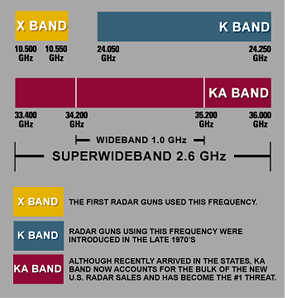
Photo courtesy of the K40 site
In 1976, the FCC introduced a second traffic radar frequency, K band.
According to the K40 site, "Since it first appeared, K band has been the most
common radar gun used by police. It represents as much as 50-60% of all radar
guns in use today."
In the late 1980s, Ka band was introduced. "With its superior targeting
accuracy, Ka band guns are quickly gaining popularity with police departments.
This gun’s only limitation is its high cost. However, as budgets increase and
more revenue generating traffic citations are issued, you most definitely will
encounter one of these top guns in the near future."
There are also two types of radar guns that drivers should be aware of,
parked and moving. These parked guns are the ones that you will see when a
police car or motorcycle is sitting on the side of the road and the officer is
aiming his radar gun at the passing traffic. Moving guns are the ones that are
mounted in police vehicle which work when the car is moving. The guns can clock
speeds of cars approaching or passing the police car. There is even a "same
lane" setting, allowing "police [to] clock vehicles while driving up
from behind."
As if that wasn’t enough, "Most of the radar guns currently being used are
also equipped to operate in "Instant-On" or "Pulse" mode. This enables a police
officer to wait until a vehicle is just close enough to be in range and then,
with the release of the trigger, send a quick burst of radar to clock its speed.
While not impossible to detect, this technique is more difficult for radar
detectors to give early warning time when compared to conventional methods.
Without a transmitted signal, there is nothing for a detector to "listen for"
until a police officer targets your vehicle or another one in front of yours."
Then there is LASER (Light Amplification by Stimulated
Emission of Radiation). "Transmitting on 904 nanometers, police
laser guns utilize a very tight, invisible beam of light which travels at
186,000 miles per second to target moving vehicles." Simply put – you don’t
have any protection from other cars on the road with you because "Laser is
nearly instantaneous and it can pick a single vehicle from a group of cars."
Police aim the beam at the most reflective spot on the vehicle, usually a
license plate, and measure speed with the bounced light beam.
"To work properly, guns have to be stationary, steady, and aimed nearly
straight on at the front or rear of the moving target."
According to K40, there are "over 30,000 laser guns are in operation
throughout North America and currently almost every state’s law enforcement
agency uses this weapon. Helping to grow this threat are laser gun manufacturers
providing police departments with evaluation units and billing them only after
enough tickets have been issued to pay for them. As a result, drivers are often
surprised to encounter police laser in areas not expected to have access to this
more expensive technology." Yikes!
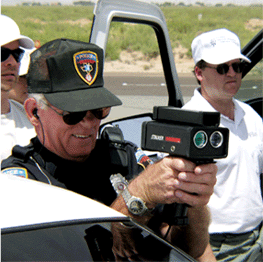
This policeman is having way too much fun with his LASER gun!
Photo courtesy of K40 site
So understanding that any speed above the set limit is fair game for a
ticket, acknowledging that most people speed at some point or another, and
realizing that the cards are stacked against you if there is a policeman
anywhere nearby with a RADAR or LASER gun, I think it only makes sense that a
detector be installed in everyone’s car as a reminder system. This way there is
less chance of jeopardizing one’s license or insurance rating over a lapse in
judgment regarding one’s driving speed.
One last, seldom mentioned benefit of having a radar detector is that some
road-crew vehicles are equipped with a radar gun that will set off detectors
coming near the work area. This is a good way to warn oncoming vehicles of
unforeseen road hazards or work crews.
Which brings us to the question of which type of detector to buy. There are
actually two. You can get a "undetectable" system which is installed in your
vehicle. With this type detector, all indicators are integrated into the
vehicle’s instrument panel, and there is nothing to give away the fact that your
vehicle has a detector. While this type system is aesthetically pleasing and
eliminates having to remove or stow anything a thief might be able to see when
the vehicle is parked, they are pricey. The alternative is a portable
system, which offers the same features but can be moved freely between vehicles.
Today, we will take a look at the K40
RD850 Portable All-Band
Radar and Laser Detector. I was personally surprised to find out that this
company has been producing radar detectors since
1981. I was
less surprised once I realized that they were probably
better known
for their
undetectable systems, which is something I haven’t yet been in the market
for.
The RD850 has what I would consider to be a typical detector shape, something
resembling a wedge of cheese on its side. Measuring approximately 5" long by
2.5" wide and 1" thick at its far end, it weighs only 3.9 ounces. It is
noticeably smaller and much lighter by half than my current detector, the
Escort Passport 8500. The RD850’s case is comprised of textured matte black
plastic broken up by areas of smooth black plastic. For the most part the case
feels very sturdy, however I did detect a slight creak on the right side of the
unit when tightly squeezed.
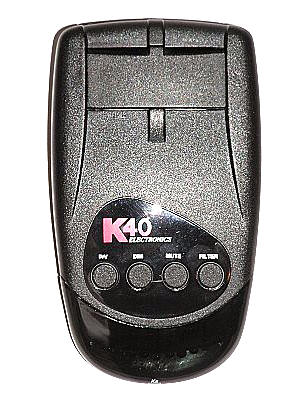

The design seems simple and uncluttered. There are just four buttons on the
front. A light panel, which is hidden by the translucent black plastic on the
front of the device, is labeled with a key for the lights that may appear.
In the Box you’ll find the RD850 portable radar detector, a visor clip mount,
two pieces of industrial strength velcro tape for dash mounting, a suction cup
windshield mount, a 24" when coiled power cord for use with the vehicle’s
cigarette lighter, as well as a 12 foot long power cord for those who prefer
hard-wiring to fuse-box, the cigarette lighter adapter, an extra fuse, an
owner’s manual and a "speeding ticket warranty registration."
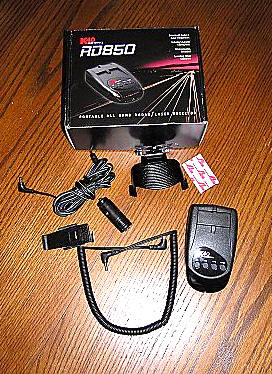
There is no storage case, so if you are one that worries about scratches from
other items in the glove box, then you might want to find a soft storage pouch.
Before installing the detector, let’s go over the buttons and lights. There
is nothing worse than being in a vehicle with a piece of equipment that you
don’t know how to operate!
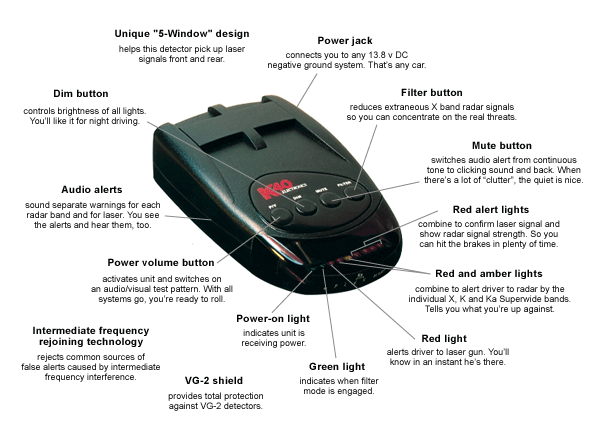
Picture courtesy of K40 site
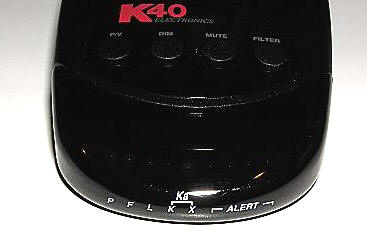
The most important buttons are the four on the front: P/V, Dim,
Mute, and Filter.
P/V – Power/Volume
Dim – Allows for dimming or brightening the lights, depending on your
preferences for day or night driving, there are three settings
Mute – Instantly reduces the chirps to a clicking sound
Filter – Similar to a City/Highway mode, it filters out much of the X
band clutter that is experienced when driving in town
The light panel on the front is read as follows:
P – Power-on Light – glows green when the RD850 is plugged in and powered
on.
F – Green Light – Indicated when you have the Filter mode turned on.
L – Red Light – Lights when a Laser gun is being used on your vehicle
K & X – Red and Amber Lights – Red glows for K, amber glows for X,
and both glow for Ka band
Alert – Red Alert Lights – These lights combine with the before mentioned
radar or laser lights to show signal strength
According to the K40 site, the RD850 employs the following features:
Advanced Microwave Radar Receiver Design – For exceptional performance to
all radar guns, including DSP driven Ka band radar.
Patented Intermediate Frequency Rejection Software Reduces non police
signals without sacrificing performance to true police radar.
Unique "5-window" design – Helps this detector pick up laser signals
front and rear, even off axis signals.
VG-2 Protection – Prevents detection from the VG-2 Gun (radar detector
detector) while emitting a brief audible and visual alert.
Pulse Protection – Immediately alerts you to police "Instant on" radar.
Installation for me was simple. I used the 2′ coiled power cord with the
cigarette lighter adapter and the suction cup windshield mount. I do have one
issue I would like to mention concerning the suction mount. While it is good
that you can use a Phillips head screwdriver to adjust it to fit the angle of
any vehicle’s windshield, I would really like to see a company either include a
pocket-sized screwdriver with their detector that you can keep in the car or
better yet, devise a method to adjust the angle that does not need a separate
tool.
When mounting this, or any detector, it is important to place it so that it
has a clear unobstructed view of the road to the front and the rear of the
vehicle. It needs to be positioned so that the driver can glance at the control
panel without it obstructing his or her view. I usually will place my detector
in the lower middle of the windshield. Here you can see it both in the Ford
3-350.
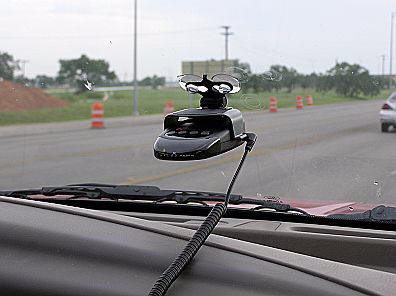
If you have a tint strip running across the top of your windshield, it
shouldn’t affect the detector, but you should keep the detector clear of
mirrored sunscreen strips and the windshield wipers as both can block the
signal. I was interested to learn that vehicles equipped a heated windshield,
brands Instaclear® and ElectriClear® were mentioned specifically, will render a
radar detector placed on the dash, windshield or visor ineffective.
Well, now we come to the portion of the review where I tell you all about the
road-testing. I had a lot of fun with this, let me tell you. Since I don’t
happen to know a policeman with a radar gun that would be willing to shut down a
city street and perform comparison and distance tests with me, I had to
improvise. There were a couple of tests that I felt I could accomplish without
the assistance of an officer-friendly.
The first test was conducted on Highway 277 south, driving 45 miles and back,
stopping in Eldorado. With the RD850 in position and set with the Filter off,
Steve and I were on our way. Unfortunately, in what has to go down as a "first
time for everything" moment, we did not encounter any police or
sheriff’s department vehicles going either way. Once we hit the town of
Eldorado, the detector predictably went off (K band) as we approached then
passed the courthouse where the sheriff’s department’s vehicles were parked. On
our return trip, the detector loudly came to life (X band) as we passed
the same spot that always drives our Passport batty – a direct line
approximately 3 miles out from the airport and
NOAA weather station. Disappointed that I wasn’t able to detect an actual
police car’s radar, I figured we would have to try something else.
The next test occurred driving through the city of San Angelo. With the
Filter once again set to off, we drove until we passed a grocery store that set
off the detector (X band). Switching the detector to Filter on, we did a second
sweep and while it still tripped the detector, it was nowhere as intense of a
reaction.
Driving around town, we got the idea of going by the DPS to see if there was
a state trooper’s car parked there that might actually have their radar switched
on. No such luck, not only were there no cars with radar on, there were no cars
at all. We weren’t out of ideas, though. We headed downtown to the San Angelo
Police Department. Sure enough – as we turned the corner two blocks over, the
RD850 began to chirp (K band). As we turned into the parking lot, we were
quickly able to ascertain which two vehicles had their radar on, as there
was a definite buzz directly behind and in front of their vehicles.
I have to admit that by this point I was growing frustrated because I wanted
a true radar test! Since we had the Passport along for the ride, I decided to
see what would happen if the two detectors were turned on at the same time. I
have always heard that cheap detectors would throw out a signal to other
detectors in the area, and today I found out that neither of these detectors is
"cheap." Not only did they not set each other off, I was able to use them in
tandem – watching to see which would react faster or slower as we drove around
town.
Driving around San Angelo got a bit more interesting at this point. We would
pass some locations and perhaps one of the detectors would chirp and the other
wouldn’t. It seemed to be fairly balanced though. I did notice there were a
couple times when the Passport would show K or Ka band, but it would only flash
momentarily then silence itself. The RD850 did not seem to be going off at all.
At this point, I unplugged the RD850 just to make sure that it wasn’t causing
some sort of effect on the Passport, but it would still do it on occasion.
That’s when I started to question whether the RD850 was even working because it
was being so quiet!
Coming up Johnson Street towards Angelo State University solved that mystery
once and for all…as we passed the Verizon building the RD850 buzzed. Expecting
perhaps an X band reading from the building itself, I was surprised to see it
read K. The Passport was remaining silent. As we moved forward a couple more
blocks, the RD850 continued to pick up – never quieting. The Passport had
finally awoken, and seemed to be giving a half-hearted K warning. Suddenly the
RD850 was going crazy – and Steve was saying, "there it is!" We could spot a
radar equipped speed warning sign several blocks away in a school zone.
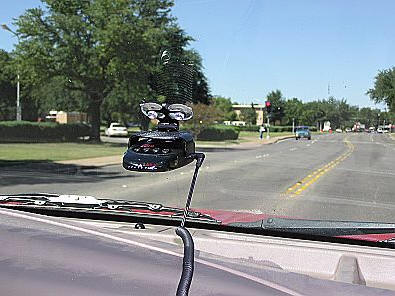
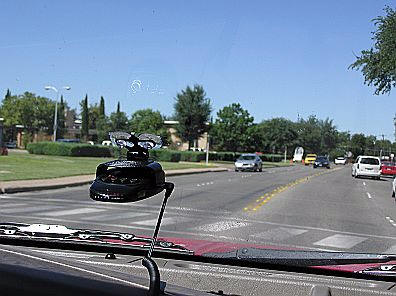
By this time, both detectors were going crazy!
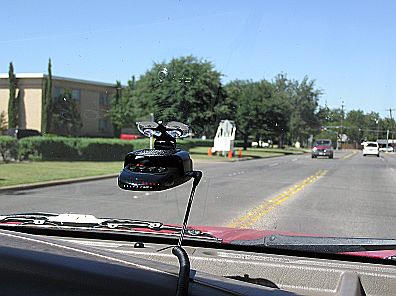
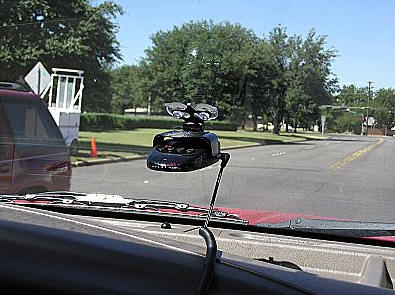
As we passed the back side of the warning sign, we decided to turn around and
approach it from the front.
This time from 6 blocks back, both radar detectors picked up the signal. It
must have been much stronger from this direction because the RD850 started
totally freaking out – the chirping turned into this loud ringing sound that
resembled my truck’s cell phone! However, all that noise was coming from the
little RD850. The Passport freaked out as well but it has an auto-mute function.
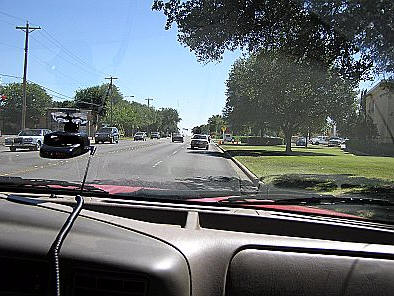
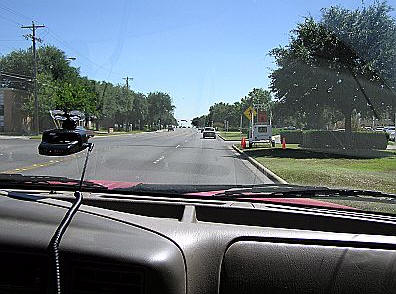
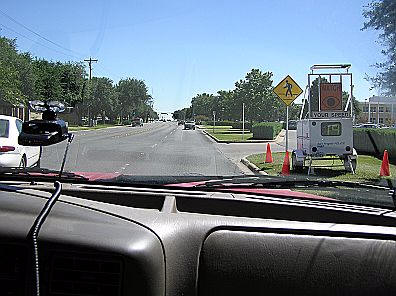
Well, that was about as scientific as I could possibly do, without law
enforcement cooperation anyway.
My conclusion? The RD850 impresses me for several reasons, one of which is
that it does not go off incessantly and for no reason at all. There will
be some X band items that will make it chirp. But since you can see the light
for X band light up, it is possible when in town to differentiate between a
possible policeman and other clutter. Or you can leave the Filter on when
driving in town. On our little road trip, the same situation applied. The
detector did not go off anywhere except for places I expected – like the
NOAA/Airport area and of course the Eldorado Sheriff’s department.
I do have a little gripe, however. The LED display on the RD850 can be hard
to read if you are trying to differentiate between X and K band. It probably
shouldn’t even matter – I mean, if it is going off then all you have to do is
check your speed and maybe tap the Mute button, but since I know what the
different bands are and what they generally mean, I like to know exactly what’s
going off and why.
Almost canceling out my little gripe is the guarantee that K40 provides with
its radar detectors. I think it may be the best one out there. Take a look and
see what you think:
You are guaranteed:
- Total immunity from speeding tickets.
K40 will pay any or all radar or laser speeding tickets you get for one year
after purchase. Make sure you send in that "Speeding Ticket Warranty
Registration" that I mentioned earlier in the review within 30 days of
purchase. The catch is that you can’t get the speeding ticket in a school zone
and you can’t get the speeding ticket while DUI or DWI. Same on you if you do
either of these things!!.
- Total guarantee of performance.
If your new RD850 does not outperform any other Radar/Laser detector
you’ve owned, return it within 7 days for full product credit.
- Total guarantee of quality workmanship.
K40 will pay for any and all repairs or replacement of defective parts for
12 months after purchase.
With that kind of guarantee, it seems almost foolish not to give the K40 a
try. I would say that it performed as well or better than my top rated Escort
Passport does. Actually in regards to X band clutter the RD850 seems quieter.
Then there is the fact that it did go off a bit earlier than the Escort Passport
did when confronted with live radar (K band) today. That is definitely something
to think about, because when you are trying to avoid tickets an early warning is
certainly the best. Fortunately, and independent lab has done technical testing
that I couldn’t even begin to duplicate, so if that sort of reading interests
you, then please have a look
here.
You can view Todd Sherman of Gainesville Florida’s handy reference to US
Radar Detector laws here.
The gist is that if you live in Washington DC or Virginia, you are not allowed
to have a radar detector. If you are a commercial trucker or you drive on a
military base, then it is illegal for you to use radar detectors. Otherwise, it
is copasetic. If you are one of the majority, that is – people who routinely
speed five to ten miles over the limit – then you should protect yourself from
tickets and use a radar detector. Just look at it as a tool to keep you on your
toes.
You can download the manual for the RD850
here.
You can search for Dealer’s that sell the K40 Electronics RD850 Portable
All-Band Radar and Laser Detector
here.
Price: $299
Pros:
Small light unit
Works as advertised
Great warranty
Does not go off gratuitously, especially X band
Will definitely catch your attention when it goes off
Comes with multiple mounting and wiring option accessories
Cons:
Can be tricky to differentiate between K and X band when it is going off
Screwdriver needed to adjust the angle of the windshield bracket – can be a pain
when swapping vehicles
Gerber Gear Suspension 12-in-1 EDC Multi-Plier Multitool with Pocket Knife, Needle Nose Pliers, Wire Cutters and More, Gifts for Men, Camping and Survival, Grey
KONDOR BLUE | EDC Multi-Tool All-in-One Bit Torque Driver for Every Day Carry On Film Sets & Cinematography | Raven Black
$89.00 (as of April 29, 2025 15:43 GMT -04:00 - More info)Product Information
| Price: | 299.0 |
| Manufacturer: | K40 Electronics |
| Pros: |
|
| Cons: |
|



Gadgeteer Comment Policy - Please read before commenting
I own a 2016 Honda Accord. I received a radar detector at Christmas from Santa aka me. Is the Electriclear the web looking material at the middle top of windshield behind rear view mirror or is than the radio antennae. Is Electriclear a full windshield layer? Plastic safety coating? Your article is very informative.